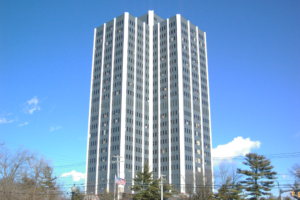
Martin Tower, located at 1170 8th Ave., Bethlehem, is scheduled to be demolished. The skyscraper used to be a part of Bethlehem Steel and opened in 1972. (Brandon Jia/B&W Sraff).
After a decade of preservation efforts, Martin Tower, previously the world headquarters of Bethlehem Steel, will be demolished, according to The Morning Call.
Opened in 1972, the vacant, 21-story building has been a fixture of the Lehigh Valley skyline. Although the developers of the land, Lewis Ronca and Norton Herrick, who bought the property in 2006, have yet to submit a master plan for the demolition of the tower to Bethlehem’s Planning Commission, three other buildings on the complex have been taken down.
And the tower is next.
Without a submitted master plan, there is no schedule yet for demolition.
Alicia Karner, the director of Bethlehem’s Community and Economic Development, said the demolition will take time.
“It will be more than two months based on our conversations with the developers,” Karner said.
Karner and Tony Hanna, executive director of the Bethlehem Redevelopment Authority, said they predict the majority of the property will be converted into a residential area.
“What this area needs is affordable housing, and it would be great if some affordable housing could be put in there,” said Lynn Cunningham, executive vice president of Bethlehem Initiatives at the Greater Lehigh Valley Chamber of Commerce.
However, the zoning ordinance set by Bethlehem City Council in 2015 states that the land must be replaced by five percent each of office and industrial; retail, restaurant and entertainment; and residential.
Receivable Management Services, the last major tenant, left the building in 2007. City council, Redevelopment Authority, and citizens have made efforts to preserve the building since, but now many have concluded that the building is obsolete.
“I think it’s a white elephant and can’t be reused,” Cunningham said. “It would be great if it could be remodeled, but that would be at an extreme investment, so the realist in me is saying that just won’t happen. It’s not marketable.”
The two options for preserving the building would involve converting it into office space or apartments.
As for apartments, Hanna said there is a large market for apartments right now — just not high-rise apartments. He said buildings like the Martin Tower would be converted into apartments in downtown Philadelphia, but it’s more difficult in Bethlehem.
Cunningham presented the challenges that exist for converting it into office spaces.
“When it comes to new companies coming in, they aren’t looking for those huge towers anymore,” Cunningham said. “They are looking for a campus with buildings that are a couple of floors and go wide.”
In 2007, city council overlaid the zoning to allow for the developers to convert the Martin Tower into apartments.
But Hanna said the council’s plans were prevented because of the 2008 market crash and the housing bubble burst.
To provide incentives for preserving the tower, the Martin Tower was placed on the National Register of Historic Places in 2010 after the developer petitioned along with city support and assistance. This allowed the developers to receive tax credits for preserving the building.
By 2015, “even with the tax credits and financial scenarios, they didn’t feel that they could save the tower,” Hanna said. That same year, the area was rezoned, which allowed for the replacement of the building to include residential and retail. The old zoning only allowed for the building to be replaced by office space if demolished.
With nearly all options exhausted, Cunningham is looking toward the future.
“Let’s move on, and let’s move forward,” Cunningham said. “That’s how I feel about it.”





Comment policy
Comments posted to The Brown and White website are reviewed by a moderator before being approved. Incendiary speech or harassing language, including comments targeted at individuals, may be deemed unacceptable and not published. Spam and other soliciting will also be declined.
The Brown and White also reserves the right to not publish entirely anonymous comments.
2 Comments
To bad that it was not built on Mountaintop Campus area. I think that any buildings on Lehigh’s main campus that existed in 1972 are still used. I’d classify Taylor Stadium as a structure and let an architectural student tell me if I’m mistaken.
Excavation and demolition techniques totally depend on selected areas